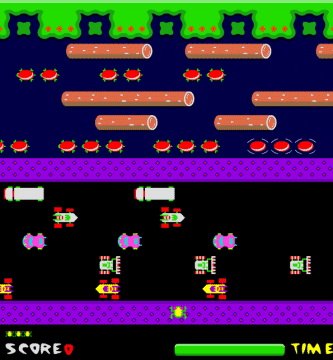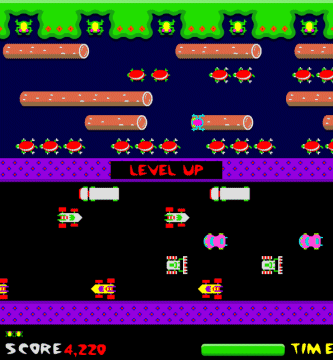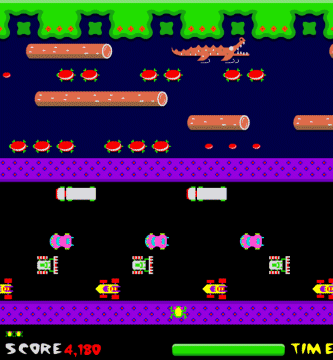Frogger - 1981
| Year: | 1981 |
| Original platform: | Arcade machine |
| Brief description: | Puzzle / adventure game |
| Number of players: | One or two |
| Developers/contributors: | Konami Industry Co. Ltd. |
Frogger was an arcade game developed by Japanese company Konami, a company that started out as a jukebox rental and repair business in 1969. Today they are one of the world's leading gaming companies, but in 1981 they had only been in the arcade game business for about three years. They had nevertheless already made an impact. Early in 1981 they produced Scramble, a shoot 'em up game in which the player controls a jet aircraft. The game was released in the USA under license by Stern Electronics Inc. They followed this up with Super Cobra, a similar type of game but this time featuring a helicopter gunship. Super Cobra was also released in the USA under license by Stern. Both games were well received. Konami were nevertheless no doubt aware of the emergence of games like Pac-Man and Donkey Kong, both hugely successful games having a much broader appeal than the average shoot 'em up.
Although Frogger was perhaps not as innovative as either Pac-Man or Donkey Kong, it was nevertheless an enormously playable and popular game, and is recognised as one of the all-time classic video arcade games. Like other successful games of the time, it was easy to play, difficult to master, and very addictive. It's also a game that is difficult to categorize. There is not much of a story line as such. The player controls a two-dimensional frog using a joystick. The game is played from a top down perspective, and the idea is to get the frog from the bottom of the screen to one of several predefined locations at the top of the screen, avoiding a number of hazards. The game has aspects that suggest an adventure game, but it is really about developing strategies to avoid the various pitfalls that lie in wait for the frog on its homeward journey. In that sense it's more of a puzzle game.
The original arcade version of Frogger was one of several arcade games to feature two microprocessors. The main processor was a Zilog Z80 running at 3.072 megahertz. This processor executed the game's program code. The second processor was also a Z80 chip, running at a slower 1.790 megahertz, which was used to control the game's sound. Frogger featured continuous background music and sound effects that varied in accordance with what was happening on the screen. The hardware also included additional dedicated sound chips. Like other arcade games of its time, Frogger could be found both in upright cabinets and in the cocktail table format. The arcade version of Frogger also featured a four-way Joystick, which was the only control required for actual gameplay.

A screenshot from the first level of an online playable version of Frogger
(http://www.happyhopper.org/)
The screenshot above is taken from a playable online version of Frogger, of which there are numerous examples to choose from. I chose this one simply because I liked the name "happyhopper". As you can see from the screenshot, our frog (one of several, in effect) starts the game at the bottom of the screen. In this part of the screen he is quite safe, but complacency is not an option here as you only have about sixty seconds to get him to one of the home locations at the top of the screen. There are five home locations, each represented by a lily pad (at least that's what they are supposed to look like) in its own small niche in the riverbank. The first obstacle that our small green amphibious hero has to contend with is the rather busy five-lane highway, which he must of course traverse to get home. Strangely, the traffic in alternate lanes goes in different directions, but maybe it's a new kind of traffic-calming scheme.
On the first level, it's not too difficult to get across the road. You can literally 'go with the flow' of traffic and wait for the gaps to appear. The frog will move one place to the left, right, up, or down each time the joystick is moved in one of these directions. For most web-based versions, the direction arrows are used instead of a joystick. The frog must avoid being hit by a moving vehicle or lose a life. Once the frog reaches the strip of land between the highway and the river, he is once more on safe ground (but remember that the clock is ticking). In the river you are once more faced with five lanes of moving objects. This time, however, you must use the objects to get the frog across the river without being drowned, hopping from one object to the next in order to get to one of the lily pads. In the first level, allof the objects are logs or turtles. The logs move from left to right across the screen, while the turtles move from right to left.
Just to make life more interesting, some of the turtles dive under the water for brief periods. If your frog happens to be on one of these turtles when it submerges, he will drown. You may of course be excused for wondering why an amphibious creature like a frog would drown, but the frogs in Frogger are apparently unable to swim. On the plus side of things, a lady frog will appear from time to time on one of the logs. If our frog hero manages to land on the spot occupied by his female counterpart, he can earn two hundred bonus points for successfully carrying her to one of the home locations. In addition, a fly may appear in one of the home locations. If a frog manages to reach the lily pad before the fly disappears, he will earn two hundred bonus points (presumably for eating the fly). Unfortunately, crocodiles also have a tendency to pop up in the home locations from time to time.
Other hazards include otters and snakes, which begin to appear after the second level. Should a frog manage to make it safely into one of the home locations, a total of one hundred and fifty points are awarded. Fifty of these points are awarded for successfully reaching a lily pad, and ten additional points are awarded for each hop that takes the frog in a forward direction (a total of ten forward hops are required to get a frog from its starting position to the far side of the river). A level is complete when you have placed a frog in each of the five home locations. One thousand points are awarded for each level completed, and a further ten points are awarded for each second remaining on the clock when a frog reaches a home location. As you have probably surmised, a frog must reach a home location before the timer expires or perish.

A level is complete when all five home locations contain a frog
You can also lose a life by mistiming your final hop into a home location (the frog must be aligned with the centre of the "lily pad"), staying on a log or a turtle too long and disappearing off the edge of the screen, or jumping into a home location already occupied by a frog. Being eaten by a crocodile, otter, or snake is another possibility, although crocodiles can be used to cross the river in the same way as logs, as long as you remember to stay away from their mouths. Snakes are pretty deadly and should be avoided at all costs. They can turn up on logs, or on the river bank. In developing a strategy for playing the game, it is worth remembering that the left-most home location is the most difficult to get into because logs, which are the objects nearest to the far bank of the river, move from left to right. Needless to say, the game gets progressively harder with each level, with faster moving objects and more predators.

From level two onwards, logs are often replaced by crocodiles
Although Frogger was a huge success in Japan, in 1981 Konami had no manufacturing or distribution facilities in the United States or Europe. They therefore turned to the Sega/Gremlin partnership established by Sega Corporation and Gremlin Industries. The main purpose of the collaboration between these two companies was to distribute Japanese arcade games to overseas markets, and in particular to the US market. Konami originally wanted to call the game "Highway Crossing Frog", but Sega came up with the name "Frogger", which certainly sounds a lot more like the name of a fun game. Although an arcade sequel was not forthcoming, the game was predictably ported to all of the popular game consoles and personal computers of the time. In the three decades or more since it first appeared, sequels, spin-offs, and clones of the game have abounded. Versions are still appearing for popular game consoles, including the Sony PlayStation, Xbox and Wii, and have also appeared for various mobile devices. Numerous online versions of the original game are also available to play.
In the tradition of games such as Space Invaders, PacMan and Donkey Kong, Frogger has left its mark on popular culture. The Frogger character has appeared in children's cartoons and animated films. In fact, the most recent appearance of the character at the time of writing was a cameo role in the Disney animated film "Wreck it Ralph", released in 2012. Almost inevitably, in 1982 Frogger became the subject of yet another game-related song ("Froggy's Lament") by U.S. pop duo Buckner and Garcia. The song featured snippets of music and sound effects taken from the game itself. A 1998 episode of U.S. sitcom "Seinfeld", entitled "The Frogger", depicts one of the show's main characters attempting to procure a Frogger arcade machine (on which his name is still credited with the highest ever score) from a local Pizza parlour. At the time of writing, the highest score ever officially recorded in real life is 970,440 points, and was achieved in July 2012 by Michael Smith of Springfield, Virginia, USA.
